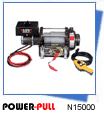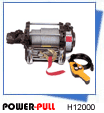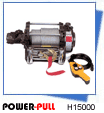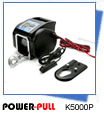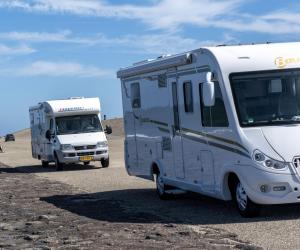特殊环境驾驶技巧之涉水驾驶
Yes, it`s me again and this time I would like to try tell you why to stay out of the water with your Land-Rover. Or even drink water. A first reason is because fish f*** in it. Yuck. All other reasons are strictly vehicle-related.

Over the years, many attempts have been made to waterproof wheeled vehicles and most failed miserably. Yes, the British army has some form of "waterproof" Air Portable Land-Rover but apart from some magazine pictures, we never got any real account of how much water got into the axles and gearbox. Making an ignition system waterproof is no big deal, they have done that with a Jeep in W.W.II, but that was a throwaway vehicle. I imagine that you want to enjoy your Land-Rover investment longer than a few months.
Where playing in the water can be great fun, and the gods know that I have done it, water will get into ABSOLUTELY everything: gearbox, axles, rubber boots, underpants and even your engine crankcase if you stay in long enough. Diesel people tend to play in water more often than others because they don't have the gasoline engine ignition problems and if their alternator light comes up on a submerged engine, they tend to ignore it because that will go out soon enough when the alternator is not submerged anymore. Bye alternator, too.
A good indication for brain rot is when people think that if a seal keeps oil in, it will keep water out. Well, I got news for you: it doesn`t. The main reason is that crankcase, axle and gearbox seals are designed to work under about 0 (zero) bar pressure, and that 1 m of water will give you 0.1 bar of pressure per cm”, which is usually enough to let water in. If your crankcase seal has an area of say 10 cm”, that means that there is 1 bar of pressure on that seal and you can bet your wife`s birthday present on it that that will not keep the water out.
So, if you MUST get wet, enjoy it to the full, BUT drain ALL oil from your vehicle THE NEXT DAY and replace it. The mayonaise-like substance that you may find in your gearbox after 2 weeks has very poor lubricating properties. Same goes for your axles and swivel joints. And if you have been driving with your engine submerged for longer than ten minutes, you may well find the same salad-dressing-colored oil in your engine as well. So this is basically all I can say about direct effects of water on your drivetrain and engine, but there are a couple of other considerations that might be added here:
When fording deep, be aware of the current. The Semois river in Belgium carried my S III 109 diesel away for 800 meters in 1979 because the loadbed end of the Land-Rover floated as I got deeper. And some of you may even remember that video in which a Camel Trophy Range Rover was swept away and submerged in a furious river in Africa in one of the very first Camel Trophies. The organizers kept very silent about that incident.
Stay off beaches ! Salt water and salt sand will do exactly the same thing to your Land-Rover as it does to shipwrecks: rust them away. And a Land-Rover chassis is a LOT thinner than the one inch of steel of a ship that the salt will eat through.
In unknown waters: attach a line to the one who is stupid enough to volunteer for a recon on foot. 1 meter of water is enough for the average Landie. Choose 2nd low (3rd low for V-8s), go in slow and keep a steady pace. Keeping the back open for emergency escape is also a good idea, you may have forgotten where that deep hole in the river bed is. On the other hand, if the water depth is less than the top of your rubber boots (Annette calls them wellies), you won`t even get any of it in your axles.
Do NOT go play in the water with 1 vehicle alone, having a backup to pull you out is always nice.
WATER (Emergency)
This is essentially an answer to someone‘s e-mail request for urgent advice / help from a flooded area in the far East. I hope it was useful.
1. Not losing power when deep fording or prolonged flood driving / diesel engine. It is essential that your engine does not cut out when moving. With a diesel, that is not much of a problem since a diesel does not rely on electricity to keep running. Let us assume that you own a diesel-engined vehicle. First, you want to raise the engine air inlet, so that your engine cannot suck up water because that may stall your engine and / or occasion connecting rods to bend which is major damage. So the best thing to do is to get some pipe, as rigid as possible, (thick PVC sanitary pipe will do) and apply this to your air intake and lead it along your windshield side up to roof level, put some form of inverted U at the top, so it does not fill with rain water either. The exhaust is not so much of a problem because the exhaust pressure of the engine will blow out any water if the exhaust is not located to deep. Anyhow it is always a good idea to raise the exhaust also up to roof level using whatever more or less heat-resistant pipe you may find. (If engine is shut off under water, with water level higher than engine top, water may enter engine by the exhaust because one or other exhaust valve will be open at any time).
So, if your diesel cannot suck up water through the air intake and if no water can enter the engine through the exhaust, that engine should keep running fine under water with no problems. NOTE: loosen the fan belt, so that the belt can slip under water because if the fan is forced to turn when submerged, it may pull itself into the radiator and cause bad damage there, some people take the fan belt off altogether for prolonged fording - the cool water in which you are driving will cool the radiator anyway. Don't forget to tighten the belt up again or put it back when out of water. Some Land-Rover products have a radiator fan with a viscous drive for this purpose - then it is no need to worry about this. 67 cm of water, however should NOT be a problem at all !
1.a. Not losing power when deep fording or prolonged flood driving / petrol engine. Gasoline engines rely on electrical spark for ignition, so what you need here is a fully waterproofed ignition system. Since I assume that you do not have the time to buy one of these somewhere, this is a trick I used a couple of times and which works well, but do not overly rely on it if your life depends on it: buy 5 or 10 kilograms of hard grease (e.g. hard bearing grease in the style of Shell Retinax or something similar). Pack the WHOLE distributor in a 1 cm layer of grease, the more , the better. Pull off ignition wires from spark plugs (after carefully marking their location) and pull over a rubber glove as to cap the head of the distributor. Think of a distributor wearing a glove full of grease and wires go through fingers. Liberally grease all ignition leads and spark plug recesses when the wires are back on the plugs (it will be shit to clean this off later, but that is not important now). Use LOTS of grease everywhere. Then you can also re-pack everything in greased medicinal gauze, and add more grease on top. The idea is to grease (insulate) all electricals that have to do with ignition to keep engine running under water or in heavy spray. Also pack all connectors on starter motor in thick grease.
2. Water ingress: in deep water, your alternator will stop working and red charge light will come up. This will go away when you are back on the dry. Also, it is absolutely necessary to put in the fording plug in the bellhousing breather hole at the back / bottom of the engine or your clutch may get soaked. Water ingress in your axles and gearbox is also very probable, so it is essential that you change the drivetrain oil VERY OFTEN (every day if you have to). Also check engine OIL very often for color change. When it looks like salad dressing, change oil because there is water in it. Also, try sealing off the oil filler aperture in engine. Engine oil breathers should be extended and ducted upwards much like the air intake and the exhaust.
3. Water / electrical resistance: Water is NOT very conductive under a tension of 12 volts, that is why you can put on the lights on the bottom of a canal. But it is not very good either. Please try to pack with grease ALL electrics you can reach. Alternator will have water ingress same for diesel or gasoline engine and the water will destroy the bearings after a couple of weeks. For both engine types: thickly pack starter motor also to prevent water ingress. You cannot pack the alternator since it needs air for cooling. But you can buy a water proof alternator later if you wish. After you packed a gasoline engine in grease, test it by pouring several buckets of water gently over the running engine and see what happens. OK if it does not stop. If the water stops the engine, find out where you need more grease.
4. Driving: as a rule of thumb, go as slow as possible, spray looks good in pictures but that is all. As said before, 67 cm for a Land-Rover is not much. But from 1 meter on, you must let the car fill with water as much as possible to get ground pressure, otherwise the car will try to float. WATCH OUT FOR CURRENTS !!!!!! In heavy current, make your car as heavy as possible. Keep all widows / roof open at all times to use as emergency exit if carried away by current. Bring / wear life jacket if you can !
I wrote my first message as fast as my fingers would allow me to so to share with you whatever advice you may most need in this emergency. Getting your stuff and your family high and dry is very important, of course, I understand that. Floods can be real bad and very damaging.
As far as I understood your message, you are now regularly crossing rivers or flooded patches for relatively short periods of time. 67 cm of water for a few hundred meters should not be much of a problem for a Land-Rover if it is a diesel. If it is a gasoline engine, it may get enough spray on your ignition system as to short it out. You asked if you can restart the engine then. Yes you should be able to restart after you carefully dry all components. Also a good idea to have a ready supply of WD40 or similar brand spray cans with which you liberally spray ALL electrical components before driving off in water and to repeat this at least once a day.
By all means, GO SLOW in water, and I mean REAL slow. Making the water spray up does not serve any purpose at all, it will only make the water ingress cavities where it would not get otherwise. It may also spray enough water into your air filter intake under the hood and destroy your engine (water is NOT compressible !) When the water is deeper than the bottom of the body of your vehicle, it will cause an upward force, same as in a boat. This makes you loose grip on the ground and the current may carry you away (it has happened to me). If it is getting deep, open doors so that your vehicle can fill with water to get more weight on the ground.
Raising the air intake: Cut appropriate hole in hood or wherever needed to get the pipes through, fasten upwards pipes to side pillar of windscreen or roof rack or whatever you can attach it to. Put snorkel pipe on air cleaner or directly on air intake without cleaner, this may be easier sometimes. Use large hose clamps or strong duct tape to make airtight and waterproof connection. I have used sanitary pipe once and it worked perfectly because you can easily find all the elbows and other funny pieces to get the pipe routing in the right direction. Keep the same diameter as the air intake. Don't worry about air filter, there is no dust when it is raining. Put an inverted U“ on top of the raised air intake so it does not fill up with rainwater while parked.
Starter motor can be temporarily waterproofed by heavily packing it in grease. Alternator cannot be packed. It may fill with water and the water inside will prevent it from charging the battery. Carry a spare charged battery if you can ! When the alternator is dry, it will work again, but you will have to replace the bearings at a later date.
Fuel tank: try sealing off filler cap with duct tape and raise the vent tubes otherwise you may create a vacuum in the tank by the pump suction and the fuel will not arrive anymore at the engine.





